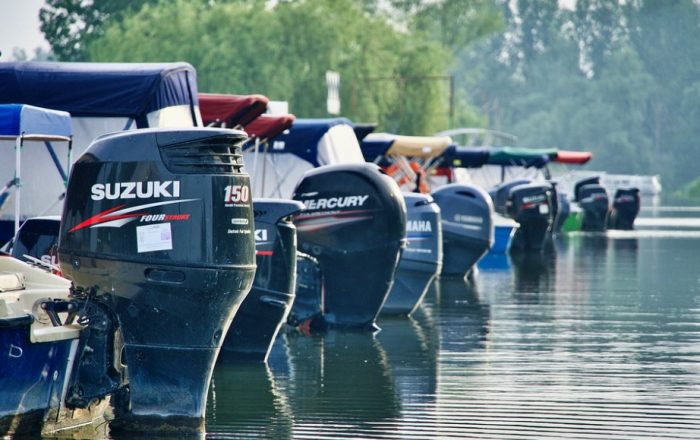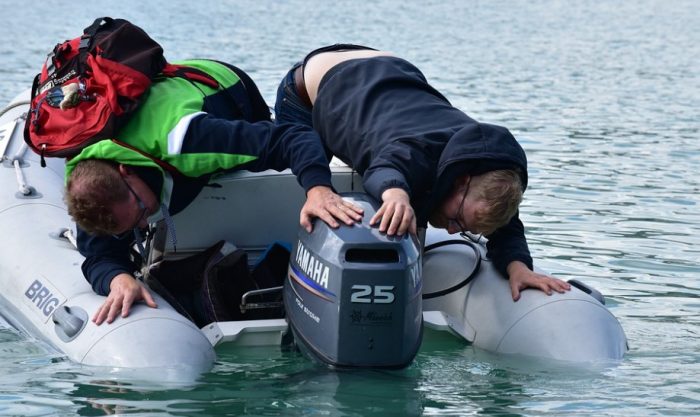An outdrive engine is one that has the drive unit or steering component outside the boat’s hull. Almost all outboard engines are outdriven, so these terms are used interchangeably. The other option for an outdrive engine is a sterndrive (inboard) which has the engine on the boat’s stern.
Key Takeaways
- Certain boat designs had sterndrives, and others had outboard engines, in the boat design you wanted to determine the engine you got
- Sterndrives were the only powerful engine option, and if you wanted 250 hp and above, you’d have to settle for a sterndrive
- Outboard engines are installed on the transom outside the boat and they burn fuel alongside oil as the lubricant
- Inboard engines are mounted in the front of the transom or inside the hull’s midsection
- Jet drives have a strong water pump that is powered by an engine and this type of engine are most commonly found on personal watercraft
Types Of Engines and Drives

There are two types of engines and two types of drives used on boats today. We have outboard engines and inboard engines, and for the drives, we have stern drives and jet drives.
This section looks at all these in detail to better clarify and understand.
Outboard engines
Outboard engines are installed on the transom outside the boat. An outboard burns fuel alongside oil as the lubricant. These engines give more power per pound of weight than inboard engines. Boats with outboard engines have a steering wheel or tiller that swivels the entire engine to direct thrust.
Outboard engines are perfect for pontoon boats because their configuration doesn’t leave enough space for installing an inboard engine. Outboard engines are also used for boats, not meant for watersports, because they would get in the way of skiing, wakeboarding, and other activities. You will mostly find this type of engine on boats meant for cruising.
Another advantage of outboard engines is that their maintenance cost is relatively low because they don’t have distributor caps and rotors. However, they still require engine oil, spark plug, oil filter gearcase lube, and water pump impeller changes.
Inboard engines
Inboard engines are also referred to as stern drive engines. They are mounted in the front of the transom or inside the hull’s midsection. Most inboard engines are four-stroke automotive engines that have been adapted for marine use. This engine turns the drive shaft that runs through the hull’s bottom and is attached to a propeller.
Most personal watercraft have inboard engines that are two-stroke and burn oil as a lubricant and fuel. The newer technology of two-stroke PWC engines is direct-injection engines that burn cleaner than their conventional counterparts. Most vessels with an inboard engine are steered by a rudder located behind the propeller.
Inboard engines are commonly found on deck boats and bowriders because these vessels have enough space for them. They are also common with boats used for watersport activities such as skiing, tubing, and wakeboarding. This is because the activities take place off the boat’s rear, making the space important, and outboard engines could get in the way.
Sterndrives
Sterndrive engines combine features of both inboard and outboard engines and are attached to a drive unit or outdrive through the transom. They are also known as inboards/outboards (I/Os). They are four-stroke automotive engines adapted for marine use, mounted inside the boat, and quieter and more fuel-efficient.
The sterndrive engine is attached to a drive unit, the lower part of the outboard, and turns a drive shaft attached to a propeller at the other end. The outdrive controls the steering of sterndrive boats by swiveling like an outboard to direct the propeller thrust.
Jet drives
Jet drives have a strong water pump that is powered by an engine. This pump takes in water and then forces a jet of water out of the vessel to thrust it forward. The vessel is steered by directing this jet of water.
Jet drives are most commonly found on personal watercraft, especially those used in shallow water conditions. Jet drives can also be used on larger vessels such as jet boats and can either be inboard or outboard jet drives.
Which is better, a sterndrive and an outboard engine?

Choosing between a sterndrive and outboard has always been straightforward until recently. This is because manufacturers built either one or the other in a certain style, so choosing the style you wanted to be meant that you settle for the power that the boat came with.
Now, you can choose the engine you want on any boat, so how do you choose? This section takes you through the pros and cons of each for easier choosing.
Pros
| Sterndrive engine | Outboard engine |
| It has a better power-to-weight ratio | Powerful and can give off more horsepower |
| Value for money | Affordable |
| Spacious enough with a large transom platform | Have a spacious cockpit and more usable boat space |
| Uses less fuel per horsepower | More affordable to maintain |
| Optimal weight distribution | Lighter |
| It offers visibility over the stern with no obstruction | It has an open swim platform |
Cons
| Sterndrive engine | Outboard engine |
| Limited access to the engine space | It uses more fuel per horsepower |
| Has a higher chance of a leak when the drive exits the boat and must be monitored | |
| Requires more winterization steps | |
| Has a great risk of fire |
Going by the table above, it is clear that outboards have more pros than cons than stern drives. This doesn’t mean that It’s all doom for stern drives, but you are better off with an outboard if you are after more wins. Some situations may force you to choose stern drives, especially if you want a craft for water sports. Consider why you need the boat to decide which engine type suits your needs best.
Final word
Nowadays, boats come with different engine types, and users have difficulty understanding and distinguishing the different options. We hope that you now know the differences between different boat engines and you can choose one that suits your specific need with ease.
References:
- https://www.quora.com/What-is-an-outdrive-engine-on-a-boat
- https://www.lakewizard.com/post/outdrive-boat
- https://www.boatingbasicsonline.com/what-is-an-outdrive-on-a-boat/

Rockey is a kayaking enthusiast who has been kayaking with a local group for the last five years. He loves using kayaks while out on outings on the water or camping when the friends want to have a BBQ party somewhere on the bank of a local lake. More About James R Rockey at About Page Here: Authors
Based on his experiences with the different types of kayaks, he is sharing his opinion about kayaking tricks and required gears so that a beginner can get started right away.
Find his team on Twitter here. Happy reading!
